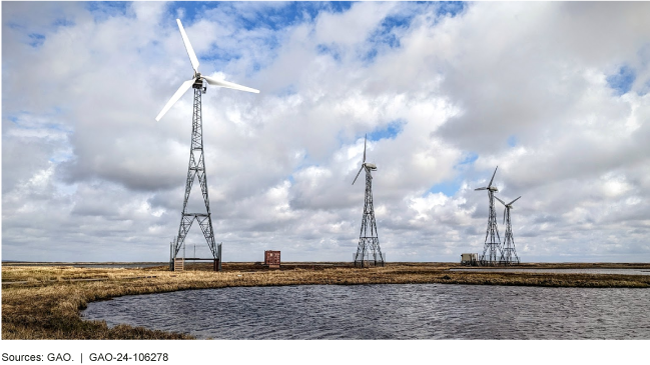Tribal Energy: Federal Assistance to Support Microgrid Development
Fast Facts
Tribes may face difficulties obtaining reliable and affordable electricity. Microgrids—electricity systems that can operate independently from a traditional electricity grid—can deliver power to tribal communities and protect from grid disruptions due to severe weather.
This Q&A report examines financial and technical challenges Tribes face with developing and operating a microgrid, including unique issues complicating efforts in remote Alaska. We explore available federal assistance and recent federal actions that could help address challenges with microgrid development, though it is too soon to know whether these actions will be successful.
Wind Turbines Supplying Power to a Microgrid in an Alaska Native Village

Highlights
What GAO Found
Multiple programs offer financial and technical assistance that can support Tribes in the development of microgrids—electricity systems that can operate independently from a traditional electricity grid. Such programs operate within the Department of the Interior's Indian Affairs organization, the Department of Energy (DOE), the Department of Homeland Security's Federal Emergency Management Agency (FEMA), the Department of Agriculture (USDA), and the Denali Commission—an independent federal agency that provides assistance in Alaska. Some of these programs have existed for years, while recent legislation has created others. The programs provide assistance within the context of their unique missions and have specific eligibility and other program requirements that applicants must meet. Accordingly, the types of tribal microgrid development projects supported vary across programs.
Tribes face a variety of challenges that may affect their ability to successfully develop microgrids. For example, Tribes face long-standing barriers to accessing federal assistance, such as limited capacity to develop complex grant applications and difficulties providing matching funds for federal grant awards. Tribes may also experience challenges with connecting microgrids to a traditional electricity grid. This can require expensive studies to demonstrate the safe and reliable connection to, and operation of, a Tribe's microgrid with utility infrastructure. Tribes in Alaska face unique challenges related to microgrids due to geographical and environmental conditions. For example, most remote communities reliant on microgrids are not connected to road systems, and barges can deliver materials only during summer months when waters are not frozen.
The federal government has recently taken actions that could foster tribal microgrid development by helping address barriers Tribes face to accessing federal assistance. For example, a December 2023 Executive Order directed federal agencies to take certain actions to increase program accessibility. Such actions include reducing administrative burdens associated with program applications, eliminating requirements to provide matching funds, and establishing tribal set-asides or other measures to prioritize funding to Tribes.
Recent federal actions could also help address broader challenges that Tribes face in their energy development efforts. For example, Indian Affairs launched an initiative to better understand challenges Tribes face with respect to these efforts—including efforts to develop microgrids—and how the federal government could better support them. Indian Affairs plans to take actions throughout fiscal year 2024 to address findings from this initiative.
While these and other recent federal actions have significant potential, it is too soon to assess the extent to which they will successfully address the barriers and challenges that Tribes face with microgrid development.
Why GAO Did This Study
Tribes and their citizens often experience difficulties obtaining reliable and affordable electricity or may not be connected to a traditional electricity grid at all. Additionally, inadequate electrical infrastructure or severe weather events can leave Tribes and their citizens without power for critical buildings and emergency services.
Microgrids provide Tribes opportunities to deliver power to their communities and improve resilience to grid disruptions. However, developing a microgrid can be a costly and complex endeavor that poses financial, technical, and other challenges. As a result, Tribes may need financial and technical assistance to develop one.
GAO was asked to examine tribal microgrid development. This report provides information on the federal programs available to support such efforts, the challenges Tribes face with microgrid development—including unique challenges with microgrids in Alaska—and actions the federal government has taken to address some of these challenges. GAO reviewed relevant laws and agency documentation, analyzed grant award data, and interviewed agency officials as well as selected Tribes and non-federal stakeholders familiar with different aspects of tribal microgrids.
For more information, contact Anna Maria Ortiz at (202) 512-3841 or ortiza@gao.gov.
